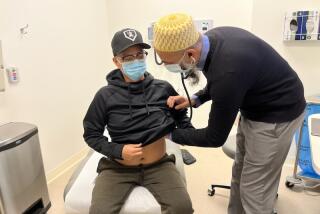AIDS-Like Cases Test Diligence of Researchers : Medicine: Scientists say an open mind should be kept in looking for a cause. Unexplained immune deficiencies may not even be linked to a virus.
ATLANTA — Physicians learn early in their careers that the best doctors are usually the ones who carefully consider all possible diagnoses, not those who jump to conclusions about their patients’ ailments.
That lesson was being taught again last week at the first scientific meeting devoted to the baffling cases of AIDS-like illnesses in people who are not infected with the human immunodeficiency virus.
The obvious leaps are to assume that the cause of these illnesses must be similar to that of AIDS and to search for a virus with similarities to the retrovirus that causes AIDS.
The obvious pitfall is that the unexplained cases of immune deficiencies may have a cause or causes that have nothing to do with an AIDS-like virus--for instance, other types of germs, genetic factors or drugs.
“Don’t think AIDS, don’t think retrovirus,” Dr. James Curran, acting deputy director of the Centers for Disease Control, said at the meeting. “Think how can we get to the bottom of what is going on.”
Dr. Anthony Fauci, the top AIDS official at the National Institutes of Health, urged scientists to continue their search for viruses while “keeping an open mind that we may not at all be dealing with a viral etiology for the syndrome.”
Working independently, Dr. Sudhir Gupta of UC Irvine and two New York City researchers have been looking for a virus. It is not clear if any researchers have found a virus or that the virus they are searching for has anything to do with the cause of the illnesses.
In the United States, the syndrome “appears to be heterogenous, it is not a single disease, not a common thread,” said Dr. Michael Merson, director of the Global Program on AIDS at the World Health Organization. “There is no obvious set of common risk factors.”
Merson said the syndrome appears to be “much, much less common” than AIDS. “We do not know if any of these cases are due to an infection with a transmissible agent. . . . We must keep an open mind.”
Despite these caveats, Curran, Fauci and Merson are haunted by their memories of the early years of the AIDS epidemic. Many believe that in the United States, at least tens of thousands of HIV infections might have been averted if public health officials had acted more decisively to safeguard the blood supply from AIDS-tainted transfusions and to alert the public to the dangers of sexual transmission of the virus.
Leading AIDS researchers have also been taken aback because many were unaware of the perplexing new syndrome until it was publicized in the news media. CDC officials have known of five cases for several years but did not inform physicians and the public until late last month. This has sparked concern that health authorities failed to do their job.
Now, the United States and other nations believe that they must be seen as acting decisively against a potential new health threat, even if the underlying message for researchers and the public is to avoid hasty analogies to AIDS and to initiate comprehensive scientific studies.
Most researchers at the Atlanta conference said it is premature to consider screening the blood supply until there is solid evidence that the syndrome is related to blood transfusions. The vast majority of human illnesses are not related to the blood supply.
The CDC, which organized the meeting, has named the new syndrome idiopathic CD4+ T-lymphocytopenia, a medical term for an unexplained low concentration of CD4-lymphocytes in the blood.
Patients must also be free of HIV infections and have no known condition associated with depletion of CD4 cells, also known as T-4 cells. They do not necessarily have to be ill.
To fit the diagnosis, patients must have CD4 cell levels of less than 300 cells per cubic millimeter of blood in two or more tests. HIV causes acquired immune deficiency syndrome by destroying CD4 cells, which are key immune system cells. A normal CD4 value is between 800 and 1,200 cells.
This preliminary definition is likely to be revised after more data is collected on potential cases, CDC officials said. About 80 possible cases are under study in the United States, a number that is dwarfed by the 230,000 reported U.S. AIDS cases.
The CDC, NIH and WHO have launched intensive inquiries of individuals who may have the syndrome.
The CDC is seeking detailed information from physicians who have seen potential cases. This information will be used to conduct epidemiologic studies that may identify common factors.
The NIH is asking physicians to submit blood specimens from patients to an NIH-supported research laboratory or to consider referring patients to the NIH Clinical Center in Bethesda, Md., for intensive study. It has established a hot line (1-800-AIDS-NIH) for physicians.
The repository of blood specimens will allow leading researchers to independently analyze samples of blood or tissues from the same patients. Many will be blind tests, meaning that the researchers will not be told until after their analyses are complete if the samples are from a possible case or a healthy individual.
The WHO is collecting international data and convening a meeting in Geneva from Sept. 28 to 30 to assess the situation. So far, there is very little information on possible cases outside the United States.
While the investigations proceed, health authorities say it would be tragic if substantial resources are diverted from AIDS prevention and treatment efforts.
“(Don’t) forget AIDS,” said the WHO’s Merson. “It is so obvious it has to be said. Five thousand new infections every day, one new infection on this planet every 15 to 20 seconds. . . . Let us remember how much there is still to do about HIV infection and AIDS. This is one message unfortunately that world leaders and the public still need to hear every day.”






